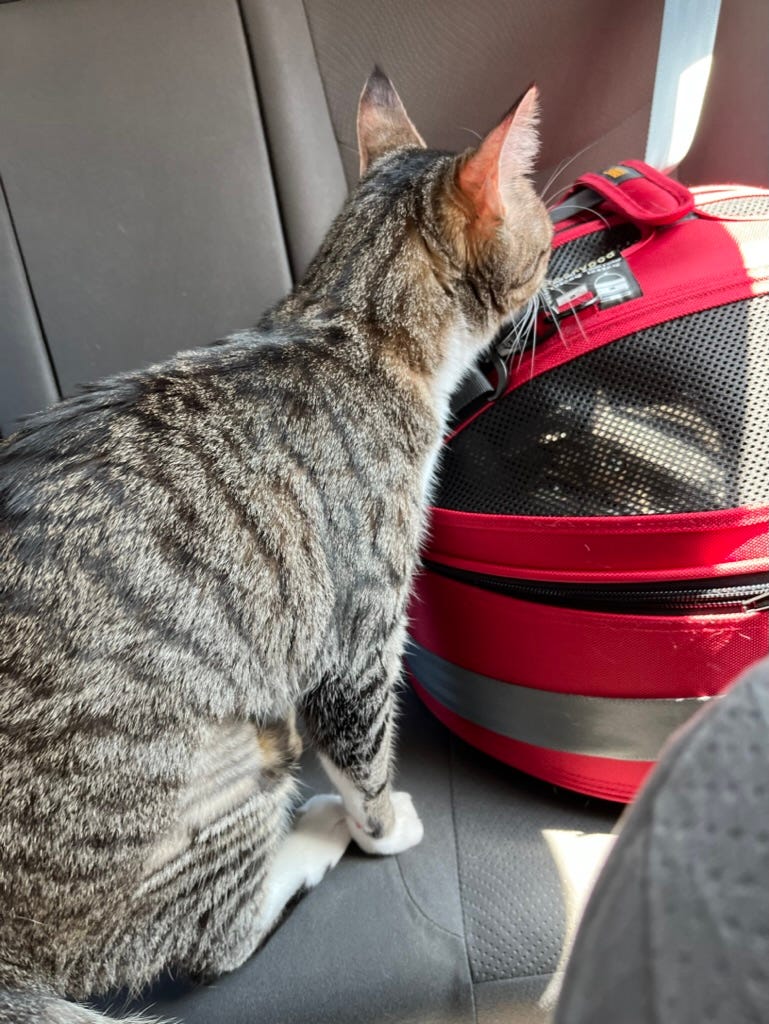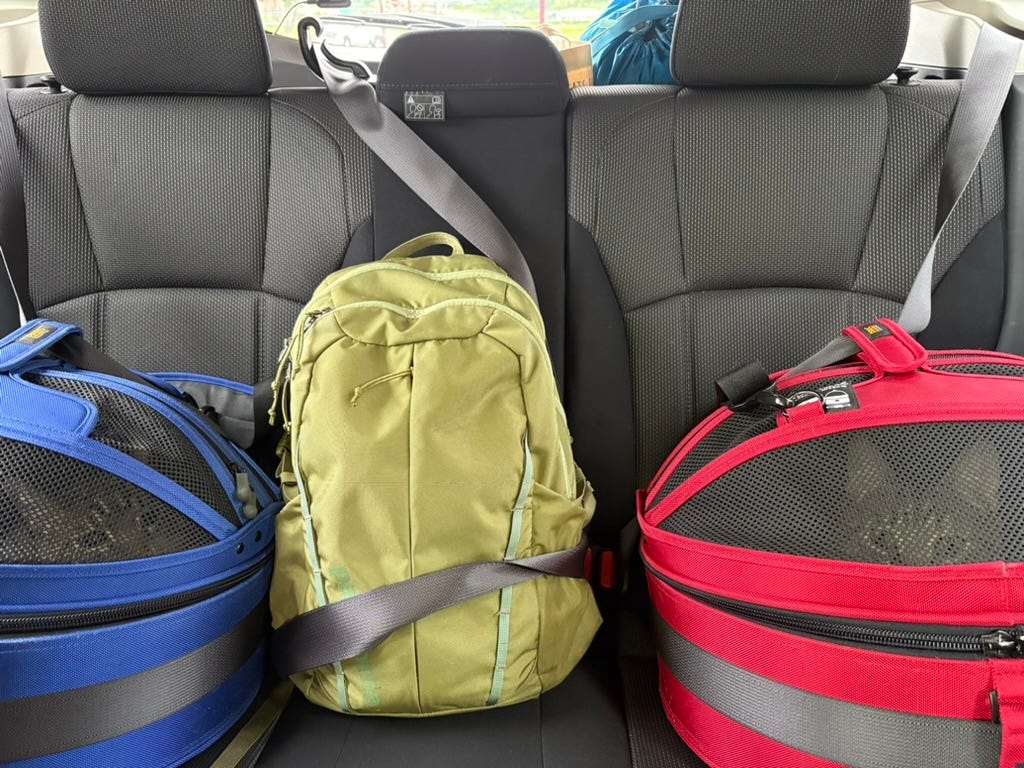You should probably have more auto insurance - even if you don't drive!
I'll show you my policy.
Why are you booing me, I’m right
Auto insurance is widely hated. People understandably don’t like paying a ton of money for something they might never use. Many Americans treat it as a nuisance: they buy the minimum liability insurance required by their state and move on.
I think more people would be happy to pay — or at least begrudgingly okay with it — if they understood how auto insurance protects them, and why they should probably have more protection than they already do.
I’ll explain by giving you a tour of my own auto policy. We’ll also discuss why non-drivers should still have auto insurance, how to shop for insurance, and how to keep the cost as low as possible.

Insurance is all about risk transfer. People driving around create two broad types of risk: damage to property and damage to people. In any given year, most people don’t encounter major damage to their vehicles or themselves, or cause major damage to others. Those fortunate people pay premiums to their insurance company, but receive nothing tangible in return — which is what many people resent about insurance in general.
No one knows in advance who will be in an accident. We just know that everyone is at risk. The only way an insurance company can afford to meet its obligations is by collecting premiums from everyone it covers, and paying benefits to the minority of people who make valid claims. When you don’t need it, insurance feels like a waste. When you do, being part of a risk pool is irreplaceable. It’s possible to receive far more from an insurance company than you’ve paid in premiums throughout your entire life. That’s possible only because most people pay more in premiums than they receive in benefits. But you shouldn’t hope for an insurance windfall — a year in which you don’t need auto insurance is a lucky year.
I recently moved to Colorado and bought a new insurance policy for my Subaru Crosstrek. Let’s walk through the different sections of my policy, and I’ll explain why the coverage I selected is so important to me. As a point of reference I’ll mention the premium that I paid for each type of coverage, but insurance pricing is highly individualized, so no one should expect their premiums to be close to mine.
Liability
Liability coverage is the bedrock of auto insurance. The different sections of an auto policy can mostly be selected like a buffet, but not liability coverage. It’s likely required in your state, although the “requirement” is fuzzy because each state may offer alternative ways to demonstrate financial responsibility. Even New Hampshire, often cited as the “live free or die” state that doesn’t mandate seat belts or insurance, isn’t all that different from other states. The part about seat belts is true! But if you don’t buy liability insurance, you have to demonstrate financial responsibility by other means, like depositing money with the state treasurer. In every state, alternatives are typically a bad idea compared to just buying insurance.1
Liability has two components: bodily injury and property damage. Liability coverage pays out if you’re responsible for injuring someone else or damaging their property while driving. It doesn’t shield you from all possible liability: your insurance will pay up to the policy limits you choose to purchase.
Insurance is regulated at the state level, so each state has its own minimum coverage required by law. A common set of limits is 25/50/25. What does that mean? If you buy that coverage, your insurance will pay for your liability up to:
$25,000 per person for bodily injury.
$50,000 per accident for bodily injury.
$25,000 per accident for property damage.
So if you injured one person in an accident, your insurance would pay no more than $25,000. The $50,000 limit kicks in only if you’re responsible for bodily injury to multiple people, and payments still can’t exceed $25,000 for any individual. Separately, this policy would pay up to $25,000 to repair or replace their vehicle.
Is that enough coverage? Sure, it is for many minor accidents. But in some cases, it leaves people woefully exposed to six-figure liability lawsuits. Michigan makes its residents sign a form if they choose policy limits below 250/500/10. The form states what everyone should know: if you select meager liability coverage, you’re leaving yourself vulnerable to a ruinous lawsuit.
Because I’m averse to being sued into bankruptcy, the limits I chose for my policy in Colorado are much higher than the state minimum. My policy from Progressive covers:
$250,000 per person for bodily injury.
$500,000 per accident for bodily injury.
$100,000 per accident for property damage.
Auto policies last for a term of six months. For that liability coverage, I paid a $216 premium (which is $36/month).
A liability policy with three numbers like 250/500/100 is called a split limit policy. Each type of coverage has its own limit. On the other hand, you may have the option to choose a combined single limit (CSL) policy, which aggregates all your liability coverage into one limit. Progressive offered me a $500K CSL policy for a nearly identical price.2
We’ll discuss an example of a massive liability suit later, but let’s move to the other sections of an auto insurance policy.
Collision & comprehensive
Collision and comprehensive are the two types of coverage that combine to protect your vehicle.
Collision coverage pays for your vehicle’s damage if you collide with another vehicle or an object like a tree. It also covers rollover accidents even if they don’t involve another vehicle.
Comprehensive coverage pays for other types of damage, including theft, vandalism, fire, and weather-related damage like flooding or hail. It also covers collisions with an animal.
If you buy these coverages, your insurance company will pay to repair damage, or to replace your vehicle if they judge that the damage is too extensive for repair.
Adding collision and comprehensive provides “full coverage”, which is more of a casual term than industry terminology. If you have an auto loan, the lender probably requires you to have collision and comprehensive coverage.
If you want to pay less for insurance and you don’t have a loan on your vehicle, collision and comprehensive are the best sections of the policy to cut back or eliminate. In their absence, you would need to be prepared to pay for all possible repairs, and replace your vehicle if it’s stolen or totaled.3 You can make your own judgment about retaining that risk. Personally, I will always pay to transfer that risk to my insurance company.
Unlike liability, damage to your vehicle has a fairly strict cost limit based on the price of repairs and the cash value of your vehicle. Since that cost is more or less capped, collision and comprehensive coverages don’t have policy limits like liability coverage. But you can still adjust the prices by changing your deductible. If you want to pay a lower premium, you can choose a higher deductible.
Unlike health insurance, you have to pay the deductible for each claim.
Let’s say you have a $500 deductible for comprehensive coverage. A rock hits your windshield while driving and the crack is too large to be repaired. An auto glass shop charges you $900 for a windshield replacement, so you owe your $500 deductible and insurance pays the rest. The same deductible applies regardless of the expense, whether it’s $900 or $30,000.
If debris causes a small chip in your glass and it only needs repair — not replacement — your insurance may waive the deductible. A few states require insurance to always waive the deductible for windshield replacement, if you have comprehensive coverage.
My policy covers:
Collision with a $500 deductible.
Comprehensive with a $1,500 deductible and $100 glass deductible.
A number of states (like Colorado) provide the option for a reduced glass deductible. If your vehicle’s glass needs work, that deductible applies instead. Because glass damage is relatively common, some people prefer this to a lower deductible across the board. I could have paid about the same for a $1,000 comprehensive deductible, with no glass deductible.
For six months of that coverage, I paid premiums of $107 for collision coverage and $182 for comprehensive coverage (about $18/month and $30/month).
Uninsured and underinsured motorists
A lot of people drive with no insurance. In the US, 15% of bodily injury claims are made against drivers with no insurance. Mississippi leads the nation at 28%, followed by New Mexico and D.C. At “only” 6%, Maine, Utah, and Idaho are on the low end.
Uninsured drivers don’t tend to have a lot of assets. Many of them are driving illegally with a suspended or revoked license. If they’re deemed liable for injuring you in an accident, you could sue them, but you may not even recover your costs. Lawyers who charge on a contingency basis — they earn a fraction of your compensation — might decline to take your case if it’s unlikely to be worth their time.
That’s why another essential part of your auto insurance is uninsured and underinsured motorist (UM/UIM) bodily injury coverage. It pays benefits for your injuries if the driver who caused the accident has less than the minimum required liability coverage.
Is it frustrating that you have to pay more for insurance because other people don’t have any? Of course. It’s not fair at all. But here’s the alternative: you leave yourself exposed to the risk of being hit by someone with no insurance and trivial assets. Your insurance won’t make you whole for medical bills, lost income, or pain and suffering. Most likely, neither will the uninsured driver.
If you have UM/UIM coverage, your insurance will pay for the gap left by the uninsured driver, but only up to the policy limits. Because this coverage is so important, some states like Connecticut mandate a minimum amount.
Coverage for uninsured motorist property damage (UMPD) is unavailable in many states. If that’s the case in your state, then uninsured motorist coverage won’t insure your vehicle against uninsured drivers — that’s what your collision coverage is for. Note the implication: if you lack UMPD and collision coverage, an uninsured driver can damage your vehicle and potentially leave you on the hook for repairs. Some states require a minimum amount of UMPD coverage.
UM/UIM coverage also pays benefits for your bodily injury in hit-and-run accidents, where the responsible party can’t be identified. Your insurance company may require evidence that another vehicle collided with yours. They don’t want to pay for a fabricated hit-and-run in which a driver blames losing control of their vehicle on someone else.
As with liability coverage, you can buy various amounts of UM/UIM coverage. It covers not only your injuries, but your passengers’ injuries as well, which can add up to a lot of money. My policy covers:
$250,000 of bodily injury per person.
$500,000 of bodily injury per accident.
As with liability coverage, this is a split limit policy abbreviated as 250/500.
For six months of that coverage, I paid a $192 premium (or $32/month). That’s higher than what I’ve paid in the past, but it’s not surprising since Colorado is above the national average for claims against uninsured drivers, at 20%.
Other coverages
Rental reimbursement coverage — AKA loss of use coverage — pays a limited amount for a rental vehicle while your car is being repaired, after you make a collision or comprehensive claim. I paid a $12 premium ($2/month) for that coverage, which provides reimbursement of up to $40/day for 30 days.
Medical payments coverage can pay for medical and funeral expenses for you as well as passengers in your vehicle, regardless of who’s at fault for the accident. I paid a $6 premium ($1/month) for $5,000 of that coverage, which isn’t vital for someone with health insurance but is worth the tiny expense. $5,000 would cover my health insurance deductible, minimizing my out-of-pocket expenses.
Personal injury protection (PIP) is a similar but broader coverage that can also pay for lost income, services like child care while disabled, and a small death benefit (i.e., a tiny life insurance payout). Most of the states that require PIP coverage are “no-fault” states like New York and Florida. “No-fault” can be a misleading term: it means that each person makes a claim with their own insurance to pay for medical expenses, regardless of who caused the accident. You still have the right to sue for severe injuries in a no-fault state. Your insurance company might use different terms for PIP coverage like “medical expense coverage”.
Roadside assistance coverage is for professional services that help with issues like a flat tire, a dead battery, or being stuck in a ditch. You don’t need to purchase this through your insurance, but it can be a convenient bundle. Personally I didn’t buy this coverage.
Gap insurance or loan/lease payoff coverage supplements your collision and comprehensive coverage if your vehicle is stolen or totaled. Let’s say you buy a new car for $40,000 and put down $5,000 (with no trade-in vehicle). You take out a $35,000 loan. Some months later, the loan balance has been paid down to $34,000 and the value of your car has rapidly depreciated to $33,000. Your car is totaled in an accident, and your insurance company pays you the cash value ($33,000) minus your collision deductible ($1,000). There’s a $2,000 gap between your $34,000 loan and the $32,000 payment from your insurance. Without gap coverage, you would have to pay that yourself. Gap coverage is relatively low-stakes, but can be helpful for people who don’t have a lot of cash on hand. I don’t have any need for gap coverage because the current balance of my auto loan is far less than the cash value of my car.
Summary of Part 1
Liability coverage pays benefits if you’re responsible for damaging other people or their property while driving. With a liability-only policy, your insurance offers no benefits for damage to you or your vehicle.
Collision and comprehensive coverages pay to repair or replace your vehicle, minus the deductible.
UM/UIM coverage pays benefits if an un- or underinsured driver, or a hit-and-run, causes you bodily injury. UMPD coverage, if available, insures your property against uninsured drivers.
Liability and UM/UIM coverages insure against the largest risks. They protect you, respectively, from catastrophic lawsuits and the financial negligence of uninsured drivers.
There are several other types of coverage you should consider. Medical payments or personal injury protection coverage may be required in your state.
That was a lot of detail. But now that we know the landscape, we can answer some interesting questions:
What if you don’t own a vehicle?
How should you shop for auto insurance?
How can you pay less for auto insurance?
How do you protect yourself against liability lawsuits that exceed your coverage limits?
This post is long enough, so that’s in Part 2! See you next week.
Further resources
Every Money IRL post is organized in The Omni-Post, and all vocab terms are here.
Episode #422 of the White Coat Investor podcast discusses how you can approach titling and insurance on vehicles driven by your teenage and college kids.
The Reddit forum r/Insurance is a decent source of real cases and some well-informed people discussing insurance.
The Insurance Information Institute has a ton of data and explanations on insurance, including the page I linked above about the prevalence of uninsured drivers. The stats I cited for uninsured driver rates might be an underestimate, since they’re calculated as the ratio of uninsured motorist claims to bodily injury claims. But not everyone has uninsured motorist coverage.
Some of the best explainers are from insurance companies. See these descriptions from Progressive of auto insurance requirements by state, non-owner auto insurance, personal umbrella insurance, liability coverage, uninsured motorist coverage, collision coverage, comprehensive coverage, medical payments coverage, personal injury protection coverage, gap coverage, and rental reimbursement coverage.
There are several good links in the further resources of Part 2. Read about life insurance if you can’t get enough.
—
We love comments here. Tell us what you like or dislike, agree or disagree with. Recall a long story barely related to this post. Ask a question!
Please send photos of your pets if you’d like to see them in future posts. Or suggest a new topic, or say hi! You can email or tap the message button. Stay safe out there.
Email: bright.tulip711@simplelogin.com
—
NH and many other states allow a surety bond in lieu of liability insurance, which is a terrible alternative for most people.
Which is better, a $500K CSL policy or a 250/500/100 split limit policy? The difference in price was $1/month, so Progressive thinks they’re similar in expectation.
In an accident where I injured one person and damaged their vehicle, the split limit policy would provide a total of only $350K: $250K for bodily injury and $100K for property damage. The $500K CSL policy provides a lot more coverage in that scenario.
But if I injured more than one person, the split limit policy might provide up to $600K: $500K for bodily injury and $100K for property damage. Here it’s potentially better than the CSL policy. To avoid worrying about this, just buy an umbrella policy!
In some cases, repair could be more expensive than the cash value of your vehicle. You might start paying to repair it, then have to scrap it and buy another vehicle when your mechanic needs to increase the repair estimate. Some damage isn’t immediately apparent. Insurance companies have a lot of experience in making these decisions.







Thankfully my fiancé made sure we have a lot of insurance coverage